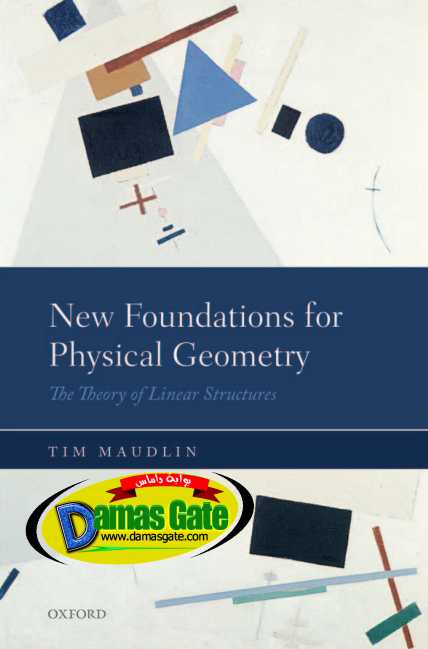Tim Maudlin - New Foundations for Physical Geometry 2014-A
Introduction
The thesis of these books is both simple and audacious. It is so simple that the basic
claims can be reduced to two sentences. First: the most fundamental geometrical
structure that organizes physical points into a space is the line. 1

Second: what endows
spacetime with its geometry is time. The remainder of these two volumes does nothing
but elucidate those sentences. Everything flows from them in such a straightforward
way that I am almost convinced that the reader could stop reading forthwith and, with
sufficient patience and diligence, reconstruct most of what follows from these two
propositions.
Description
Product Details
Book Title: New Foundations for Physical Geometry: The Theory of Linear Structures
Book Author: Tim Maudlin (Author)
Hardcover: 376 pages
Publisher: Oxford University Press (May 15, 2014)
Language: English
ISBN-10: 0198701306
ISBN-13: 978-0198701309
Book Description
Publication Date: May 15, 2014
Topology is the mathematical study of the most basic geometrical structure of a space. Mathematical physics uses topological spaces as the formal means for describing physical space and time. This book proposes a completely new mathematical structure for describing geometrical notions such as continuity, connectedness, boundaries of sets, and so on, in order to provide a better mathematical tool for understanding space-time. This is the initial volume in a two-volume set, the first of which develops the mathematical structure and the second of which applies it to classical and Relativistic physics.
The book begins with a brief historical review of the development of mathematics as it relates to geometry, and an overview of standard topology. The new theory, the Theory of Linear Structures, is presented and compared to standard topology. The Theory of Linear Structures replaces the foundational notion of standard topology, the open set, with the notion of a continuous line. Axioms for the Theory of Linear Structures are laid down, and definitions of other geometrical notions developed in those terms. Various novel geometrical properties, such as a space being intrinsically directed, are defined using these resources. Applications of the theory to discrete spaces (where the standard theory of open sets gets little purchase) are particularly noted. The mathematics is developed up through homotopy theory and compactness, along with ways to represent both affine (straight line) and metrical structure.
About the Author
Tim Maudlin was born and raised in Washington DC. Having received his BA in Physics and Philosophy from Yale and his PhD in History and Philosophy of Science from the University of Pittsburgh, he was a faculty member at Rutgers University for a quarter century before joining New York University in 2011. He has been a visiting professor of philosophy at Harvard.
Download
http://s18.alxa.net/s18/srvs2/02/003...try.2014-A.rar
Introduction
The thesis of these books is both simple and audacious. It is so simple that the basic
claims can be reduced to two sentences. First: the most fundamental geometrical
structure that organizes physical points into a space is the line. 1

Second: what endows
spacetime with its geometry is time. The remainder of these two volumes does nothing
but elucidate those sentences. Everything flows from them in such a straightforward
way that I am almost convinced that the reader could stop reading forthwith and, with
sufficient patience and diligence, reconstruct most of what follows from these two
propositions.
Description
Product Details
Book Title: New Foundations for Physical Geometry: The Theory of Linear Structures
Book Author: Tim Maudlin (Author)
Hardcover: 376 pages
Publisher: Oxford University Press (May 15, 2014)
Language: English
ISBN-10: 0198701306
ISBN-13: 978-0198701309
Book Description
Publication Date: May 15, 2014
Topology is the mathematical study of the most basic geometrical structure of a space. Mathematical physics uses topological spaces as the formal means for describing physical space and time. This book proposes a completely new mathematical structure for describing geometrical notions such as continuity, connectedness, boundaries of sets, and so on, in order to provide a better mathematical tool for understanding space-time. This is the initial volume in a two-volume set, the first of which develops the mathematical structure and the second of which applies it to classical and Relativistic physics.
The book begins with a brief historical review of the development of mathematics as it relates to geometry, and an overview of standard topology. The new theory, the Theory of Linear Structures, is presented and compared to standard topology. The Theory of Linear Structures replaces the foundational notion of standard topology, the open set, with the notion of a continuous line. Axioms for the Theory of Linear Structures are laid down, and definitions of other geometrical notions developed in those terms. Various novel geometrical properties, such as a space being intrinsically directed, are defined using these resources. Applications of the theory to discrete spaces (where the standard theory of open sets gets little purchase) are particularly noted. The mathematics is developed up through homotopy theory and compactness, along with ways to represent both affine (straight line) and metrical structure.
About the Author
Tim Maudlin was born and raised in Washington DC. Having received his BA in Physics and Philosophy from Yale and his PhD in History and Philosophy of Science from the University of Pittsburgh, he was a faculty member at Rutgers University for a quarter century before joining New York University in 2011. He has been a visiting professor of philosophy at Harvard.
Download
http://s18.alxa.net/s18/srvs2/02/003...try.2014-A.rar